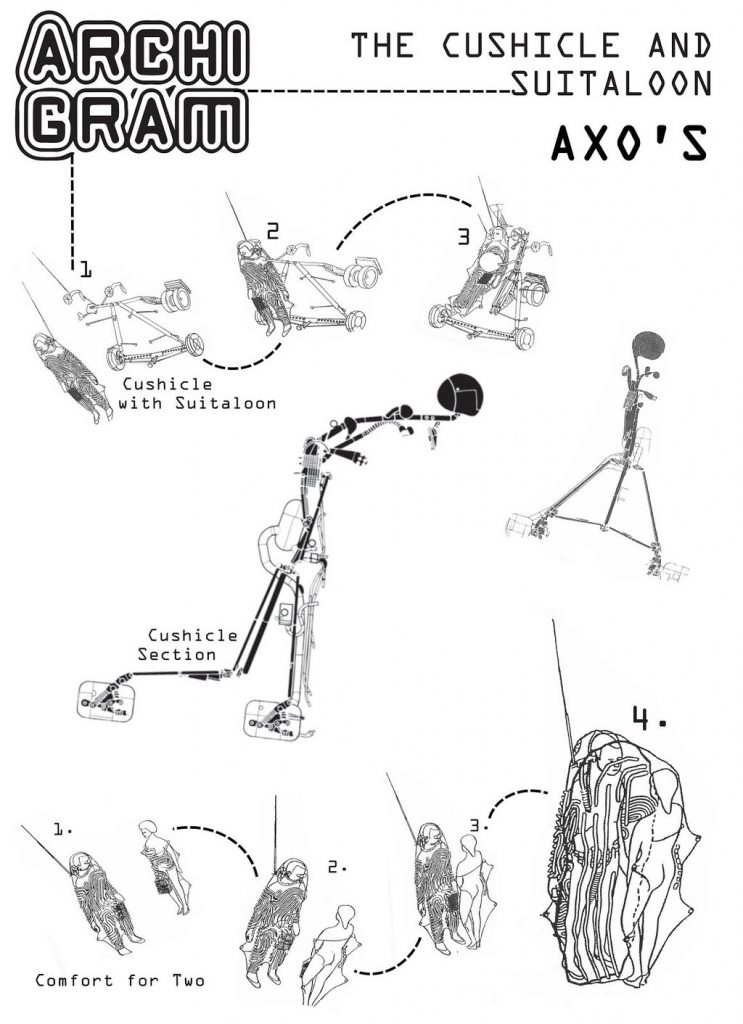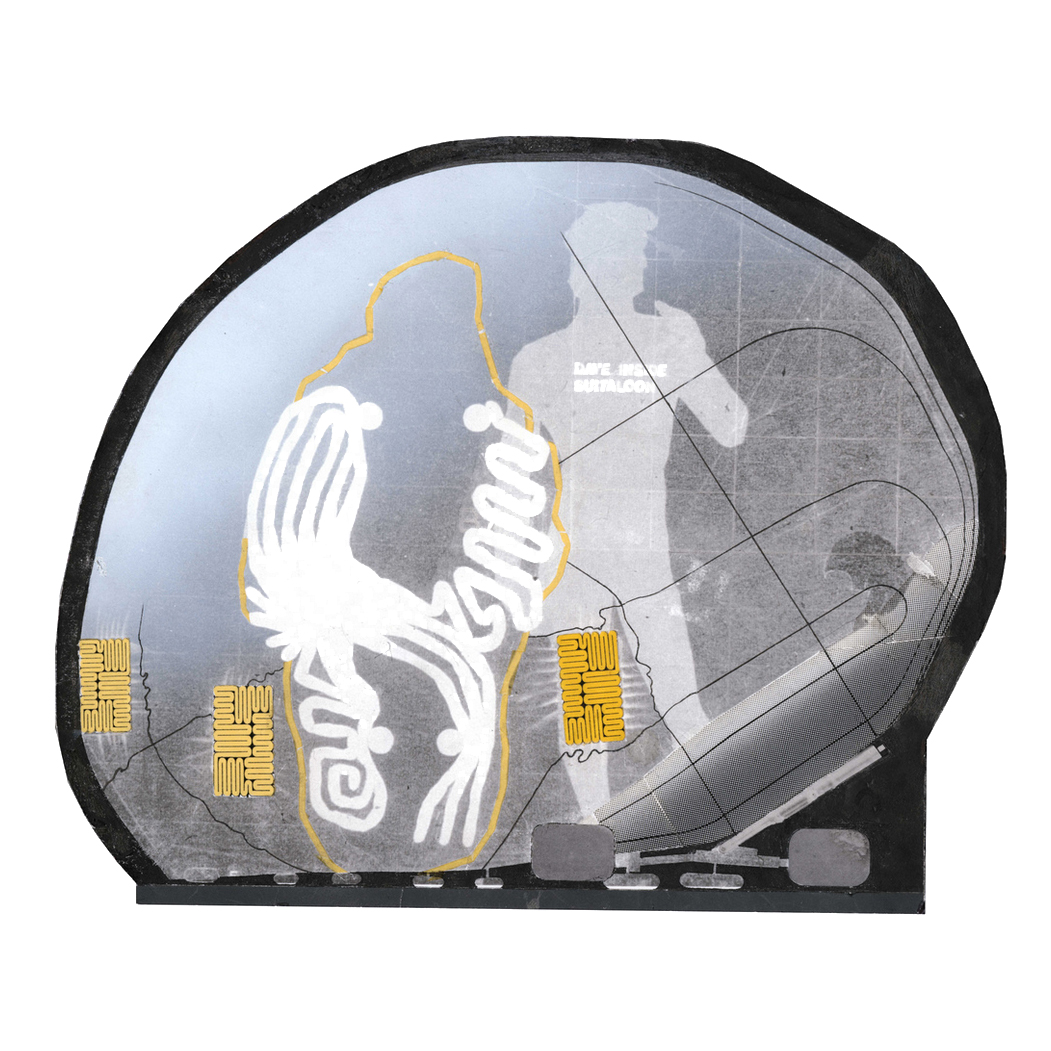During the sixties, the architecture of Archigram produced a revolution within the radical and utopian proposals that started to appear after the Second World War. This group of architects were deeply influenced by the Pop Art, the Science Fiction comics and the new technology transformations that were producing from the Cold War. Archigram proposed a new relation between the individual and the city based on large movable infrastructures that could be adapted to an environment in constant transformation. This large scale allowed Archigram to propose radical speculations regarding to the form we live in the city. Nevertheless, they also had a high degree of fantasy and this fact provoked that they could hardly be relevant within the architectonic scene.
Durante los años 60, la aparición de Archigram supuso una revolución dentro de las propuestas más utópicas o radicales que empezaban a aparecer tras el fin de la Segunda Guerra Mundial. Este grupo de arquitectos que estaban profundamente influenciados por el arte pop, el mundo del cómic y las nuevas transformaciones tecnológicas que surgían de la Guerra fría proponían una nueva relación entre el individuo y la ciudad basado en grandes infraestructuras móviles que se adaptaban a las condiciones del entorno incierto y cambiante. Esta escala gigantesca permitía especulaciones radicales en el modo de habitar la ciudad pero al mismo tiempo las dotaba de un alto grado de fantasía que difícilmente las hacía relevantes dentro del panorama arquitectónico.

Michael Webb figure was an exception within Archigram. He was able to work with the same speculative intensity that their colleagues, but at the same time, he worked in a more modest scale, humanizing the technological advances and relating them with the domesticity and routines of the users.
La figura de Michael Webb fue una excepción dentro de Archigram. Sin reducir la intensidad especulativa en sus propuestas fue capaz de alcanzar una escala más modesta que humanizaba los avances tecnológicos con la domesticidad de los propios usuarios.
The Cushicle as a theoretical approach and the Suitaloon as a built prototype are the most explicit example of this small scale approach.
El Cushicle como aproximación teórica y el Suitaloon como prototipo construido son el ejemplo más explicito de este enfoque a pequeña escala.

Both proposals responds to the Dwelling capsule concept that was one of the main cores of Archigram proposals. As Peter Cook stated in 1967, the pre-packaged frozen lunch was a basic expression of human requirement and the symbol of its efficient interpretation. Within this frame, Webb’s projects are the maximum expression of this new dogma: a suit that covers all the basic necessities for living and it can become a inflatable chamber for living.
Ambas propuestas tratan el tema de la cápsula habitacional, uno de los principales intereses de Archigram. Peter Cook afirmó en 1967 que el pack de comida precongelada era la expresión más básica de las necesidades humanas y al mismo tiempo un símbolo de su interpretación más eficiente. Dentro de este enfoque, los dos proyectos de Webb pueden considerarse como la máxima expresión de este nuevo dogma. En el caso construido del Suitaloon un traje que cubre todas las necesidades básicas para sobrevivir en un entorno urbano y que se puede inflar para convertirse en una cámara habitacional.
The minimal house is the extreme version of a capsule, the radical room.
El traje se convierte en una versión extrema de una vivienda mínima, de una cápsula.

At the same time, the prototypes displayed the paradigm change in the postwar world with a more integrated and transparent society. It is symptotamic that Michael Webb designed the Suitaloon the same year Guy Debord presented the Society of Spectacle. For the French theorist, everything that was directly lived has moved away into a representation. The architecture is an object with a powerful ideological meaning. Within this approach the Cushicle and the Suitaloon are not just a prototype for an utopian society but as a symbol to a more open and exposed humanity. They prepare teh space for a selective isolation (inflating and deinflating the bubble) becoming the user into a socially autonomous person but dependant of the available technology At the same time, the transparent plastic projects the user as a transparent figure to the exterior.
Al mismo tiempo, estos prototipos proyectan el cambio de paradigma del mundo de la posguerra en una sociedad más integrada y transparente. Resulta sintomático que el mismo año que Michael Webb diseña el Suitealoon, Guy Debord presentase La Sociedad del Espectáculo en el que afirma que todos los actos se han convertido en pura representación. La arquitectura se convierte en un objeto con un poderoso mensaje. Dentro de este enfoque el Cushicle y el Suitaloon se muestran no solo como un prototipo para una sociedad utópica sino como un símbolo de esta nueva sociedad más abierta y expuesta. Permiten al individuo un aislamiento selectivo (al inflar y desinflar la burbuja) convirtiéndolo en un ser autónomo socialmente pero dependiente de la tecnología disponible, pero al mismo tiempo, el plástico transparente con que se protege del exterior lo proyecta como un ser transparente frente al exterior.
*All images and drawings by Michael Webb.








